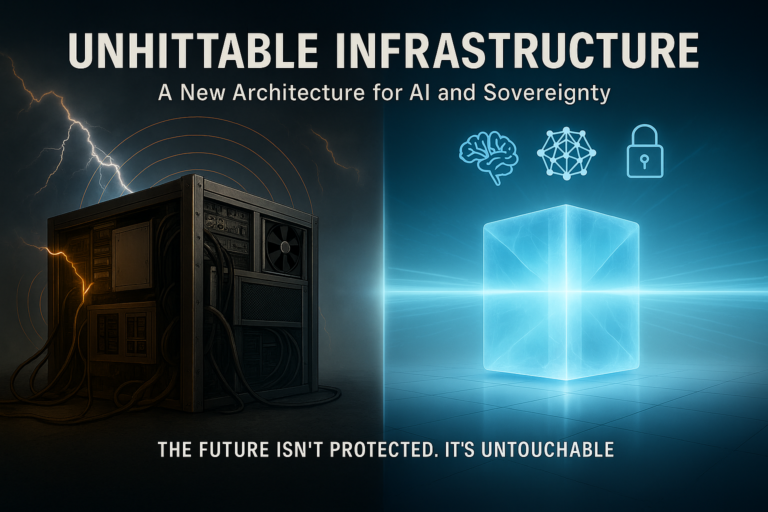In a story that reads more like a Bond villain plot than a tech strategy, Microsoft has begun submerging sealed data centers off the coast of Scotland — an attempt to cool the ever-heating hardware that powers the modern cloud.
It’s creative. Maybe even necessary. But it also signals something deeper: a computing architecture at the edge of collapse.
Silicon is breaking.
And the world is spending billions to pretend it isn’t.
“We’re witnessing the tailspin of a collapsing era,” says Derek W. Bailey, CEO of True Photonic, the company behind what may be the most radical — and logical — reimagining of computing in over 70 years.
“Water isn’t the solution. Light is.”
A Global Infrastructure Crisis
Data centers now consume more energy than the entire airline industry. The explosion of artificial intelligence, combined with our dependence on always-on cloud systems, has pushed demand for compute through the stratosphere.
But Moore’s Law is dead. More silicon no longer delivers more performance — only more heat.
To keep chips from melting, the industry is spending billions on increasingly extreme cooling tactics:
- Arctic server farms
- Underwater pods
- Floating barges
- Cavernous liquid-cooling chambers beneath the Earth
“The tech’s getting hotter,” Bailey says, “and the answers are getting colder.”
A New Architecture — Powered by Light
While the industry fights to keep silicon alive, True Photonic is building something fundamentally different: A computer that doesn’t run on electrons.
At its core is the Poovey Switch, a light-actuated transistor that uses photons — not electrons — to process logic. That means no electrical heat, no bottlenecks, and virtually no energy loss.
Combined with proprietary optical logic gates, it forms the foundation of a new class of compute:
- Femtosecond logic speeds — up to 5,700X faster than today’s providers
- 90% less energy consumption
- No exotic cooling required
- Scales cleanly, securely, and sustainably
Bailey calls it the post-silicon cloud — and unlike many firms claiming photonic progress, True Photonic’s system is fully optical from end to end:
“We’re not converting anything back to electrons,” Bailey says. “No wires.No fallback. No energy-losing conversion layers. Like our name- this is a True Photonic architecture — zero electricity required for logic, switching, or interconnects. That’s never been done.”
When Workarounds Cost More Than Innovation
Microsoft’s underwater capsules reportedly cost tens of millions — just for a proof of concept. They must withstand corrosion, marine interference, and can only be updated by retrieving them from the seafloor.
Even if they work, they don’t fix the root issue: silicon was never designed for this era.
“It’s like the brilliant minds of 1946 spending the equivalent of billions trying to improve the vacuum tube — just as the transistor was about to change everything,” Bailey says.
“I have to smile as I watch history repeat itself in real time.”
In contrast, True Photonic’s system uses nearly all its energy for computation, not cooling.
No water tanks. No vaults. Just near light-speed logic.
Another Solution That’s Beyond the Cloud — and Off the Planet
Microsoft’s ocean capsules aren’t alone. In 2024, Lonestar Data Holdings launched a data pod to the Moon, via SpaceX. Their vision: use lunar cold and solar energy to create the most remote, tamper-resistant cloud imaginable.
They aim to launch full satellite-based cloud services by 2027. Another U.S. firm, Starcloud, hopes to beat them there.
“It’s like putting the vaults at the back of the bank,” said Lonestar’s president.
“Harder to hack. Harder to reach.” Why space? Because Earth is running out of land, power, and cooling capacity.
“We’re watching the industry try everything — the Moon, the ocean, and probably Mars next,” Bailey says.
“That’s not innovation. That’s escape. Instead of putting computing on the Moon and under the ocean, we decided to simply fix it.”
Then he adds, quietly:
“Less than 100 of our photonic nodes — running at femtosecond speeds — could replace the computing power of the entire planet… while using 94% less energy.”
Compute Becomes a Commodity — But Not All Compute Is Equal
True Photonic’s model isn’t just faster — it’s smarter.
Instead of selling its processors (which have been designated a national security asset), the company is offering access to compute through a tokenized utility model.
Enter: PCC — the Photonic Compute Credit token.
- 1 PCC = 4.5 Pflop-hours of compute
- Benchmarked against AWS HPC (~$35/Pflop-hour)
- Built entirely in the U.S., under sovereign protection
This isn’t speculative crypto.
It’s digital access to physical infrastructure — at a time when compute itself is becoming the world’s most valuable resource.
“There’s a moment in every industry,” Bailey says, “when stopgaps become insanity. That’s when something truly new gets permission to win.”
The Age of Light — Not Ice — Is Coming
Bailey went on to say… “Microsoft’s capsules. Lonestar’s lunar vaults. Multi-billion-dollar climate control systems buried beneath the Earth. These are not solutions. They are symptoms.”
Silicon has reached its limit.
And the proof is in how far — and how cold — we’re willing to go just to keep it alive.
Photonic computing isn’t a faster chip.
It’s a full-system reboot.
Where electrons heat and lag, photons move freely.
Where others build vaults, True Photonic builds velocity.
No extra cooling. No middlemen. No legacy drag.
Just pure, sovereign, light-speed compute.Bailey’s bet isn’t on the deep ocean or distant Moon.
It’s on something closer — and far more scalable.
It’s on light.




